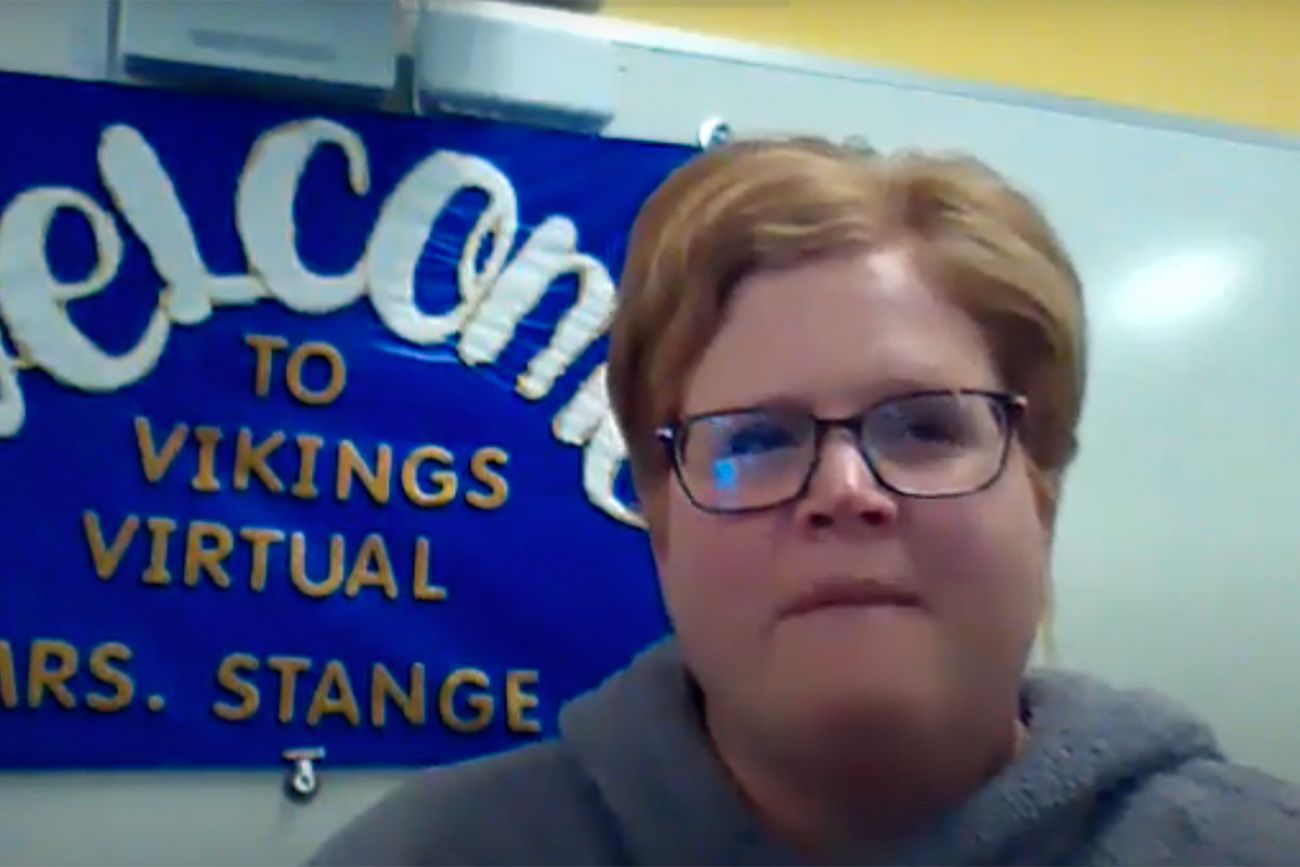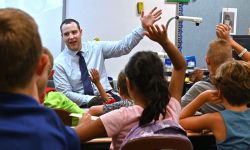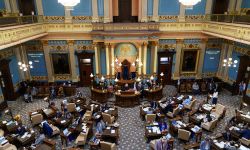Blank screens, distracted students: Michigan teachers on COVID classrooms

One described it as the worst experience of her professional life. Several said they were frustrated and depressed. And all agreed the COVID pandemic has exposed or expanded learning gaps among students.
Bridge Michigan recently hosted a virtual roundtable with six teachers from across Michigan who led classrooms this fall from kindergarten through 12th grade. While some said the experience of teaching online has made them better teachers, they worry that the learning loss among a portion of their students during the pandemic will be felt in classrooms for years.
The roundtable offered a sobering window into the world of pandemic education faced by the state’s roughly 100,000 teachers since Gov. Gretchen Whitmer ordered all public and private schools to close buildings and switch to remote learning March 16. Schools closed for the remainder of the school year, but were given the option to reopen this past fall.
Some districts still have not reopened classrooms, while others have lurched between in-person teaching and online instruction, as COVID-19 cases rose and fell across regions of the state. Michigan health officials ordered all high schools closed from mid-November through the holiday break as Michigan cases skyrocketed, noting that the virus spread was greater in higher grades.
Students struggling online
Switching between classroom and online learning has been tough for students and teachers, according to educators who participated in the Bridge discussion.
“When they get back in the classroom, they are extremely grateful,” said Jamie Pietron, a middle school special education teacher in the Anchor Bay Public Schools in Macomb County. “But when we were told we had to go back to virtual, you could see them being crushed. It’s just impossible for them to get on all the Zoom [classes] and keep up with the work.”
Mark Carlson teaches high school math in Armada Area Schools in Macomb County, where about 80 percent of students were in face-to-face classrooms before the state ordered high schools to go remote in November. The students are back in class this week.
“The kids who are face-to-face seem to like school more than ever,” Carlson said. But among those who chose to learn online, about half are flunking his classes.
“The [academically] upper 35 to 40 percent are just fine,” Carlson said. “But those kids are going to be fine in any educational setting. The middle of the road kids to the low-end kids … those are the kids who are [struggling].”
“Teaching virtually is like teaching with a blindfold on. Our students aren’t turning on their cameras, so you’re teaching for hours staring into a blank screen with very little response.” — Ferndale High science teacher Maurice Telesford
An early study of national student test data this fall found learning losses in math, but not in reading skills. The study may underestimate learning loss from the pandemic, because among the student test takers, there was a low percentage of low-income students, who may be more impacted by academic disparities when learning at home.
There is no statewide test data available in Michigan for students in fall 2020, but Bridge Michigan interviews with superintendents suggest school districts expect the achievement gap between poor and non-poor students to grow this year.
At Ferndale High School in Oakland County, where classes have been online since March, younger students in classes of science teacher Maurice Telesford are floundering.
The seniors are “not covering as much material, because we don’t meet as frequently, but we have about 90 percent attendance, students are doing the work, they’re asking for help,” Telesford said. “They came in with a skillset that was strong already.
“But the freshmen are really struggling,” Telesford said. “I probably have about half the class that is not passing right now. The transition from middle to high school, it’s a big jump in rigor.”
“The motivation is just not there to even get on a Zoom,” added a frustrated Carlson. “And we can’t pull them along because they aren’t even on Zoom.”
At Cheboygan High School at the northern tip of the Lower Peninsula, social studies teacher Adam Bedwin also noticed a drop in learning when all high schools switched to remote learning in November. Prior to the order, the school had been open for in-person instruction with a remote learning option.
“When we went online in November, a lot of our students who were in classrooms, they just dropped off the radar,” Bedwin said. “If kids don’t know how to type or know how to get online, it’s going to be a challenge.”
Blank screens, few laughs
Ferndale’s Telesford recalled his “darkest moment” of the fall, when he realized how little interpersonal interaction he’d had with students while teaching science online.
“I probably heard students laugh this semester four times,” Telesford said. “And that’s depressing. I’ve only had a class that had an off-topic discussion once this year. And we all know those off-topic discussions are moments students sometimes appreciate the most, spending 15 minutes discussing sweet potato pie versus pumpkin pie.
“Teaching virtually is like teaching with a blindfold on,” Telesford said. “Our students aren’t turning on their cameras, so you’re teaching for hours staring into a blank screen with very little response. For a lot of teachers, this has been a depressing year because they’re missing out on the relationships they build with students.”
Thomas Kawel, an English teacher at East Grand Rapids High School, said he misses personal relationships with fellow teachers. East Grand Rapids had in-person learning for part of the fall semester, and fully remote instruction as cases spiked in November.
“It’s the hallway conversations” that are missing from remote instruction, Kawel said. “We are not truly able to convene and collaborate and strengthen our craft in a meaningful way.
“My department has met several times, in a socially distanced way, but it’s not the same,” Kawel said. “And this is no one’s fault; it’s the time we’re living in.”
The teachers interviewed said they’re working more hours than in a regular school year, with some preparing lessons for remote-learning students at night and teaching in classrooms during the day.
“It’s not that I don’t want to do my job,” said Carlson of Armada. “But I’m not going to do four jobs. Let’s just temper our expectations, I’m doing my very best. I have to have a life and I have a family. When my day is over, I can’t be expected to do another job.”
Heidi Stange, a literacy coach and elementary teacher at Cadillac Area Public Schools, said she was reassigned to four jobs in four months this fall as the district moved the veteran teacher to fill needs caused by the pandemic. She has spent most of the school year to date teaching online to kindergartners, first- and second-graders. At one point, she was teaching 150 students over the course of the day, preparing live, online lessons for three grades.
“I am 100 percent burned out,” Stange said. “I can retire in a year and a half, and I can’t tell you how many times I’ve been on the [Michigan’s Office of Retirement Services] website running numbers, trying to figure it out. It has been the worst year of my life.”
Pietron, the Anchor Bay special education teacher, said she feels teachers are sometimes labeled as villains by families that see their children struggling with homebound learning. For most of the fall, Pietron taught in-person while also talking into a camera to students enrolled online. Anchor Bay switched to fully remote learning in early November when there “weren’t enough bodies” who weren’t sick or in quarantine to lead classrooms.
“Parents say [schools] should be open [because] families who want a virtual option have a virtual option,” Pietron said. “But what they fail to realize is I don’t have an option. I have [fellow teachers] who have medical conditions who can’t return to work.”
Schools across the country have scrambled to adapt to online learning while retrofitting classrooms with plexiglass and spaced desks students learning in-person. In Michigan, students and teachers also are required to wear masks.
The teachers participating in the Bridge roundtable acknowledged that many of the challenges were likely unavoidable during the worst pandemic in a century, and that working through them may well improve their teaching in the long run.
Ferndale’s Telesford said schools are doing a better job teaching students remotely than they did in the spring, when classrooms were shuttered virtually overnight. And Stange of Cadillac said the limited time she has online with students has taught her to “make every second count,” a lesson she said she’ll carry with her after classrooms return to normal.
Cheboygan’s Bedwin suggested the state can help teachers by mandating additional planning time during the pandemic to give teachers more room to put together online lessons. That’s been done elsewhere — in Minnesota, for instance, Gov. Tim Walz signed an executive order in November mandating an extra 30 minutes of planning time a day for online learning.
Armada’s Carlson urged the Whitmer administration to make faster decisions on schools. Whitmer and state legislative leaders allowed schools to make their own choices about whether to open classrooms this fall or remain online, but other pandemic-related rules — from safety standards to whether districts must meet standard day and hour instruction requirements — took too long.
“Make decisions in a timely fashion so districts can make plans,” Carlson said.
Ferndale’s Telesford and East Grand Rapids’ Kawel said they hope schools’ struggles to meet students’ needs during the pandemic will lead policymakers to look seriously at education reform, from additional funding to greater broadband access across the state.
“I’d love it if someone convened a body to put together a 20-year plan of, here’s what we want schools to do and here’s how we get there, without changing every four years when there’s an election,” Telesford said.
“We love our students, we love our jobs,” Kawel said. “Public education is what makes the state work. But we are going to see teachers burn out.
“We are getting to a breaking point if Michigan is going to take education seriously.”
Michigan Education Watch
Michigan Education Watch is made possible by generous financial support from:
Subscribe to Michigan Education Watch
See what new members are saying about why they donated to Bridge Michigan:
- “In order for this information to be accurate and unbiased it must be underwritten by its readers, not by special interests.” - Larry S.
- “Not many other media sources report on the topics Bridge does.” - Susan B.
- “Your journalism is outstanding and rare these days.” - Mark S.
If you want to ensure the future of nonpartisan, nonprofit Michigan journalism, please become a member today. You, too, will be asked why you donated and maybe we'll feature your quote next time!






